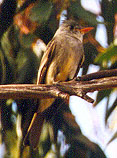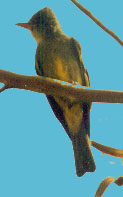A fairly large Contopus flycatcher recalling Olive-sided Flycatcher, but with a longer tail, much more peaked crest, and closed vest.
Occasionally the bird gave a "pip-pip" call when perched and once gave the same call in mid-flight. This call was similar to that of Olive-sided Flycatcher, but was more musical in tone, and was invariably doubled. Olive-sided usually gives this call three times.
The bill was quite long and flat, triangular in shape with a slight hook at the tip. The lower mandible was entirely pale all the way to the tip while the upper mandible was dark.
The face was gray, slightly paler than the pointed crest, but darker than a diffuse pale gray area in the lores.
At first I thought there was a narrow whitish crescent behind the eye but closer views revealed that the mark behind
the eye was slightly pointed or almond-shaped, recalling the pattern on a Western Flycatcher. Nevertheless, this
marking was inconspicuous and from a distance the bird did not appear to have an eye-ring. 
The throat was very pale gray, contrasting with the somewhat darker gray breast. The gray of the breast extended down the sides and flanks forming a closed-vested appearance. This contrasted with the pale belly and undertail coverts which were strongly washed with yellowish.
The tail was long and dark with a square tip, although at some angles the tip appeared slightly notched.
The tertials and inner secondaries were fringed with pale gray while the greater and median wing-coverts were tipped with a brownish-gray. Thus the wing-bars were rather faint, and not as prominant as the tertial and secondary fringes. The primary projection was quite long with the wing-tip extending a third to half way down the tail depending on the angle of view and the position of the wing. I was able to count 5-6 black primaries beyond the folded tertials. I believe the longest two primaries (8th and 9th?) were about equal. Extremely narrow pale fringes were visible at the tips of the 2-3 shortest visible primaries. The ground color of the wings were quite dark and in some light appeared to have a brownish cast.
The upperparts were medium gray, slightly paler on the rump and around the nape and sides of the neck.
The legs and feet were dark.

